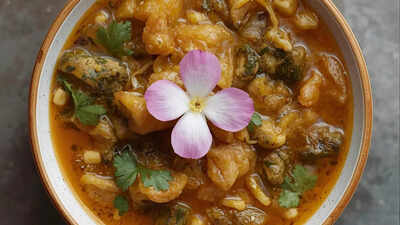ARTICLE AD BOX

Mahua flowers have been a staple in Bundelkhand’s diet for generations. Blooming abundantly in the summer months, they are harvested carefully and used in both sweet and savoury dishes.
Nutritionally, mahua flowers are an excellent source of slow-release carbohydrates, essential minerals, and a modest amount of protein, making them ideal for breakfast when the body needs energy for the day ahead.Beyond nutrition, mahua flowers hold cultural importance. They are often used in local festivals and rituals, symbolising prosperity and well-being. Their versatility allows them to be incorporated into a variety of dishes, showcasing the ingenuity and resourcefulness of Bundelkhand’s culinary traditions.
How to prepare Bundelkhand wild flower breakfast at home
Preparation begins with selecting fresh mahua flowers and cleaning them thoroughly. The flowers are then dried and ground into a fine powder. This powder forms the base of the dish, which is mixed with wheat flour to create a soft dough. Traditional spices are added to enhance flavour.The dough is shaped into small dumplings or patties, which are then steamed until soft and fluffy. Steaming preserves the nutritional content of the flowers and flour, while also producing a light and easily digestible dish.
The result is a breakfast that is not only delicious but also provides sustained energy, making it perfect for starting a busy day.
Nutritional benefits of Bundelkhand wild flower breakfast

This traditional breakfast is packed with nutrients. The mahua flowers provide slow-release carbohydrates for steady energy, while wheat flour adds fibre, aiding digestion and helping maintain stable energy levels.Spices such as cumin and coriander enhance flavour and offer additional benefits.
Cumin supports digestion, while coriander is rich in antioxidants and has been associated with general wellness. Together, these ingredients make the dish both tasty and healthful.
Cultural importance of Bundelkhand wild flower breakfast
The wildflower breakfast is more than just a meal; it reflects Bundelkhand’s connection to nature. Using locally sourced wild flowers promotes sustainable harvesting practices and supports local biodiversity.Foraging for indigenous ingredients like mahua flowers also fosters community engagement and preserves traditional culinary knowledge.
By continuing these practices, communities maintain both their cultural heritage and a sustainable approach to food.
Modern adaptations of Bundelkhand wild flower breakfast

While the traditional recipe remains popular locally, the wild flower breakfast is gradually gaining attention among health-conscious eaters and culinary enthusiasts outside the region. Modern adaptations may include pairing the steamed dumplings with yoghurt, honey, or fresh fruits, making the dish more versatile while retaining its authentic flavours.Interest in indigenous and sustainable foods continues to grow, and dishes like the Bundelkhand wild flower breakfast are excellent examples of how traditional recipes can be celebrated in contemporary kitchens.The Bundelkhand wild flower breakfast is a wholesome, energy-boosting dish that combines nutrition, tradition, and sustainability. Made from mahua flowers, wheat flour, and subtle spices, it provides a balanced start to the day while reflecting the rich cultural heritage of the region.Whether enjoyed in Bundelkhand or recreated in kitchens around the world, this dish demonstrates the importance of preserving traditional food practices and embracing natural ingredients. For anyone seeking a nutritious, vegetarian, and culturally rich breakfast, the Bundelkhand wildflower breakfast is a dish worth trying.Disclaimer: This article is for general informational purposes only and is not a substitute for professional medical advice, diagnosis, or treatment. Always seek the guidance of a qualified healthcare provider regarding any medical condition or lifestyle change.Also read| How to keep chapatis soft for hours: Easy tips for fluffy rotis every time



.png)
.png)
.png)
















 3 hours ago
4
3 hours ago
4







 English (US) ·
English (US) ·